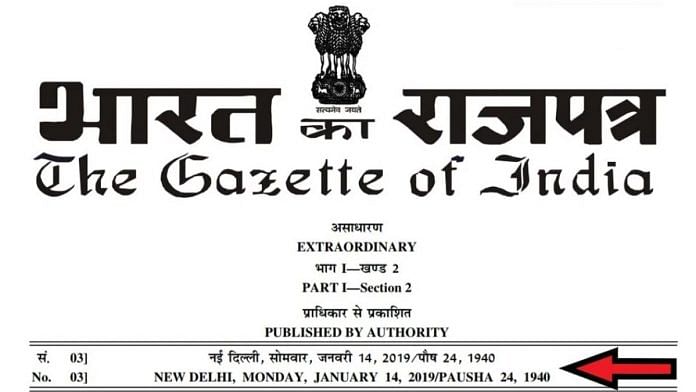All central and state government notifications published in the Gazette of India mention the ‘date’ as per two calendars – the Gregorian calendar, which was the official calendar of the British Empire, and the Saka-era calendar, which was adopted by India in 1957.
However, the Gregorian (English) year is now part of the common parlance, and most urban millennials are perhaps not even familiar with the names of the months as per the Saka era.
What is a Gazette
A Gazette is a public journal, where all government notifications, policy statements, land acquisition notices, senior officials’ postings, and international treaties are published. The noun gazette is derived from the Italian word gazzetta to describe the 17th-century Venetian news sheets which cost a gazeta, a Venetian coin equivalent to a penny. Others suggest that the word comes from gazza, a kind of bird — specifically a chattering magpie — that was used to spread the news. The first newspaper published in India in 1780 was called Hicky’s Bengal Gazette, but it ceased publication after a few years.
Since 1877, the Gazette of India has been a government publication and signifies its stamp of authority on any document. Both the central and state governments have a designated press. The Government Press, Faridabad is the nodal agency for the Centre, while Saraswati Press is for West Bengal and Government Press, Roorkee for Uttarakhand.
After 2015, the Government of India decided to do away with the physical version, and many state governments followed suit. Citizens can now download and print all Gazette notifications free of cost, and per the provisions of the Information Technology Act 2000, these copies would be sufficient for all official and legal purposes. The transition to e-printing has led to a saving of Rs 40 crore every year, besides 90 tonnes of paper and substantial quantities of chemicals and dyes.
Also read: 6 borders, 1 LoC, 4 forces—Challenges of guarding India in face of suicides, fratricides
The Saka-era calendar
Immediately after Independence, there was a demand that all government notifications be published as per calendars based on India’s indigenous knowledge systems. However, India had multiple calendar traditions, and privileging one over the other became a divisive issue – much like the linguistic reorganisation of states.
As such, in 1955, a seven-member Calendar Reform Committee was set up in the Council of Scientific and Industrial Research (CSIR), New Delhi, under the chairmanship of the noted astrophysicist Meghnad Saha.
The task before the committee was to “prepare an accurate calendar based on a scientific study that could be adopted uniformly across the country”. It was challenging because each calendar had its own unique narrative, occupying the minds of the people in that region and reflecting a deep power struggle of hegemonic assertions. The competing popular calendars in vogue included the Bikrami, Kali, Bangla, Fazli, and Nanak Shahi, and each had its strong adherents and proponents.
Finally, after the committee examined the relative merits of each calendar, it recommended that the Saka era calendar be adopted. Also called the Shalivahana Shaka calendar, it was used in the four southern states besides Odisha and Saurashtra (now Gujarat).
The Saka era marks the remembrance of King Shalivahana’s military triumphs. The first indication of a relationship between the King and the Saka era was authenticated by the Kannada work Udbhata Kavya by Somaraja, a Veerashaiva scholar.
In many ways, this was also meant to assuage the feelings of the southern states, which were feeling let down after the States Reorganisation Commission (SRC) had rejected the suggestion to name Hyderabad as India’s winter capital a year ago. The major challenge came from the Bikrami calendar, which was closely aligned with the Hindi heartland and was also the official calendar of Nepal.
Also read: People of Himachal have decided to go with Modi; all other factors irrelevant: CM Thakur on poll eve
Fortunately, the names of months in all the Indic calendar traditions were common: Chaitra, Vaisakha, Jyeshta, Ashad, Sravan, Bhadra, Asvina, Kartika, Agrahayana, Pausa, Magha, and Phalguna. Then-Prime Minister Jawaharlal Nehru wrote, “These calendars are the natural result of our past political and cultural history and partly represent past political divisions in the country. Now that we have attained independence, it is obviously desirable that there should be a certain uniformity in the calendar for our civic, social and other purposes and that this should be based on a scientific approach to this problem.”
The usage started officially on the first day of Chaitra, 1879, which corresponds to 22 March 1957. From this day, government notifications, All India Radio (AIR) announcements, and calendars issued by the central and state governments include dates according to the Saka era.
As the director of the Lal Bahadur Shastri National Academy of Administration (LBSNAA), I ensured that the session schedule issued at the institute included a reference to the Saka era. The first day of Chaitra is also the day of the equinox – when the duration of the day and night are equal.
In many ways, this is far more scientific, and in the context of the Indian subcontinent, the agricultural season corresponds to the calendar. But it may be noted that in the Nanakshahi and Bangla calendars, the new year is marked by the first day of Baisakhi.
For the record, the oldest extant calendar in India is the 5098 years old Saptarishi calendar of Kashmir, which is still issued every year by Kashmiri Pandits.
Sanjeev Chopra is a former IAS officer and Festival Director of Valley of Words. Till recently, he was the Director of the Lal Bahadur Shastri National Academy of Administration. He tweets @ChopraSanjeev. Views are personal.
(Edited by Tarannum Khan)



